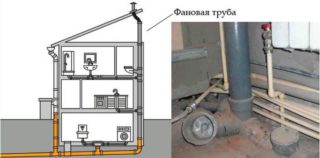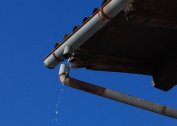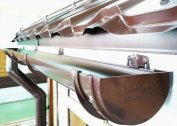In a country house where there is no centralized sewage system, a septic tank is equipped to collect sewage and consumed water. In order to prevent the water in the system and in the siphons from being absorbed into the tank, a mediator between the septic tank and the atmosphere is built into the pipes. This sewer link responsible for the removal of gases is called a sewer pipe. It prevents the breakdown of the valve and the appearance of an unpleasant odor in the room. A fan pipe is not always built in, but under certain conditions it is necessary if:
- The house has more than one floor, each with toilets and bathtubs.
- In a one-story house there are several bathrooms.
- The building has risers with a diameter of fifty centimeters.
- On the site there is a swimming pool, a bathhouse and a Jacuzzi.
- Septic is located near the house.
- Sewer pipes are located under a slight slope.
What a fan pipe is made of
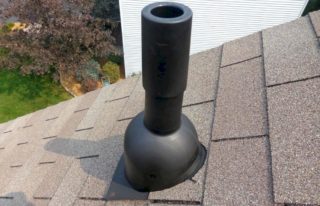 Material for fan pipes is cast iron and plastic. The main condition for a high-quality fan pipe is that it must be mounted from the same material. Currently, cast-iron pipes are rarely installed due to installation difficulties and the tendency of metal to corrosion. They are made of gray cast iron with the addition of plate graphite by centrifugal casting. Finished products inside and out are coated with an anti-corrosion compound and tested for strength under strong pressure. For the connection, expensive welding is used.
Material for fan pipes is cast iron and plastic. The main condition for a high-quality fan pipe is that it must be mounted from the same material. Currently, cast-iron pipes are rarely installed due to installation difficulties and the tendency of metal to corrosion. They are made of gray cast iron with the addition of plate graphite by centrifugal casting. Finished products inside and out are coated with an anti-corrosion compound and tested for strength under strong pressure. For the connection, expensive welding is used.
Polyvinyl chloride or propylene pipes are resistant to temperature changes and aggressive environments, mechanical stress, are easily connected. This does not require welding or soldering, just insert one end of the pipe into the other. For sealing, a rubber ring is inserted into the bell. For the production of plastic pipes, extrusion is most often used - the most non-toxic technology. By means of an extruder machine, pipes are extruded from molten plastic.
How to mount
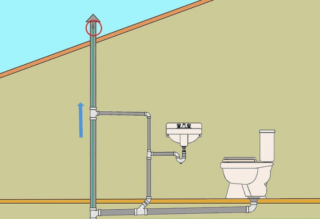 For the effective functioning of the fan pipe, it is necessary to observe some conditions, namely:
For the effective functioning of the fan pipe, it is necessary to observe some conditions, namely:
- The diameter of the pipe and riser should not differ significantly (the most acceptable option is 110 mm).
- It should end 30-50 cm from the ridge of the roof.
- To establish the outlet link, the leeward side of the building is required.
- It is allowed to connect several sewer risers to one fan pipe.
- Do not use the remnants of the previous system to avoid material heterogeneity.
- Silicone is more reliable for sealing the joints of flexible pipes (but it is difficult to get rid of it during dismantling). To strengthen the fasteners, metal fasteners are desirable.
- To protect against noise in the pipe, you can use mineral wool and a vibration absorber.
- To control the slope of the pipe and protect the premises from gas, from birds sitting on the pipe, from the ingress of foreign objects, it will not be unnecessary to install a check valve. It happens external and internal (for cleaning of various raids).
- It is necessary to ensure the temperature and pressure difference, which carries out the withdrawal of gases. For this, the beginning of the sewage system is warm, and the end is cold.
Before directly connecting the fan pipe and the sewage system, it is necessary to install a penetration on the roof, for this it is necessary:
- Penetrate through the roof by removing a piece of insulation.
- Determine the location for the hole into which the pipe is discharged.
- The hole in the metal marks the center of the circle for the outlet of the pipe (a self-tapping screw is screwed inside).
- For the exact connection of the pipe and the outlet, an intermediary is inserted between them - a corrugated pipe.
- A hole stencil is put on the center on a self-tapping screw, and a hole in the roof is made along its contour.
- The sealant is attached with a sealant without vinegar and self-tapping screws. It is designed for waterproofing (does not allow melt or rain water to penetrate).
- The next step is fixing the penetration base to the roof and the seal.
- A sewer conduit with a corrugated pipe is put on the passage element installed through the roof and applied to the roof.
- From the inside, a vapor seal seal is installed on the vapor barrier film.
- Connected fan and corrugated pipes.
Installation and operation errors
 At the slightest deviation from the installation rules, the expected effect of the sewer system will never be achieved. Disruptions in operation also lead to many troubles. Therefore, you should know what is an error during installation and operation of the entire system:
At the slightest deviation from the installation rules, the expected effect of the sewer system will never be achieved. Disruptions in operation also lead to many troubles. Therefore, you should know what is an error during installation and operation of the entire system:
- Connection to a fan pipe of other types of ventilation. When combined with a chimney from a boiler or furnace, the pipe ignites.
- Installation near a balcony or window at a distance of less than 4 meters (all the “aroma” will fall into the room).
- No exposure to the mass of snow, which may break the device.
- Installation of umbrellas over the pipe to ennoble the view or weathercocks, as this leads to the formation of condensation.
- Racks for the fan pipe have constrictions or bends. This leads to resistance to air flow.
- An uninsulated sewer outlet is inserted, which freezes in severe frosts.
- Small volume siphons are installed in which water dries quickly. As a result of this, the gases unhindered make the room atmosphere unfavorable.
- Incorrect calculation of the volume of wastewater leads to a lack of footage of sewer pipes.
- The pipes are installed at the wrong slope (ideally - the surface slope for a pipe with a diameter of 110 mm should be 2 cm).
- The pipe is not used for its intended purpose, that is, from the outside to install what is intended for indoor service.
- The withdrawal of its own sewer into a river or pond. Instead of saving, you usually have to spend a budget on fines for environmental pollution.
Proper installation of the fan pipe, even with long-term inactivity of the sewer, allows the air in the building to always stay fresh.
